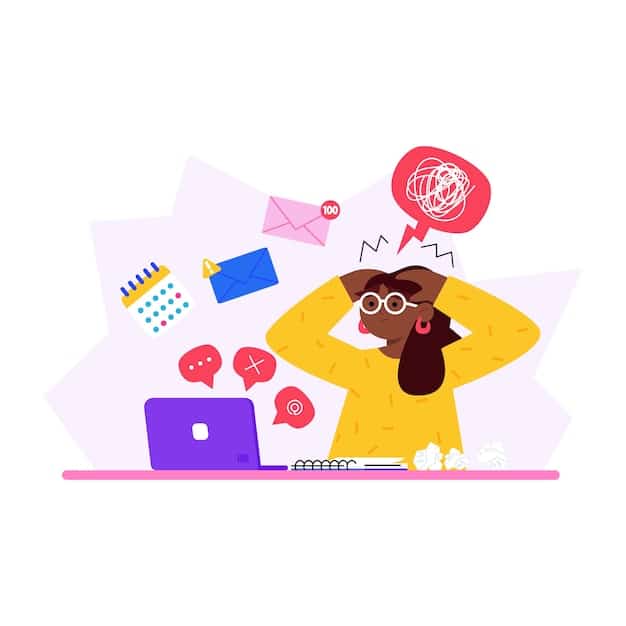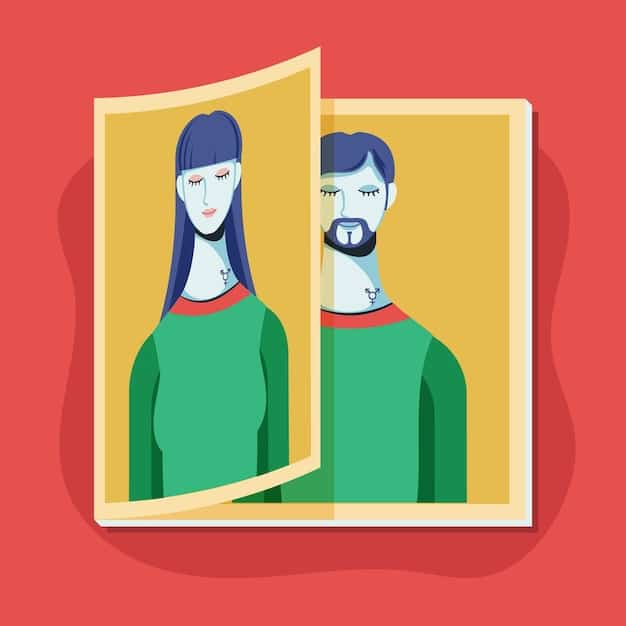Digital Minimalism: Declutter Your Tech Life & Reclaim Time

Digital minimalism is a philosophy that encourages individuals to intentionally and selectively use technology to align with their values and priorities, reducing the negative impact of digital overload on mental well-being and productivity.
In today’s hyper-connected world, it’s easy to feel overwhelmed by the constant barrage of notifications, emails, and social media updates. The concept of digital minimalism offers a refreshing antidote, providing a framework for reclaiming your time and attention by intentionally decluttering your tech life. Let’s explore how this philosophy can help you regain control and cultivate a more intentional relationship with technology.
Understanding the Core Principles of Digital Minimalism
Digital minimalism isn’t about completely abandoning technology; it’s a conscious decision to use technology in a way that serves your values and goals, rather than distracts from them. It’s about being intentional with your tech use and minimizing the noise to focus on what truly matters.
The Digital Declutter Process
The core of digital minimalism involves a structured process of decluttering your digital life. This includes identifying which technologies are essential and which ones are simply draining your time and attention.
- Identify Optional Technologies: List all the technologies you use regularly that aren’t essential for work or core relationships. This could include social media apps, streaming services, or news websites.
- 30-Day Detox: Take a 30-day break from these optional technologies. This period allows you to experience life without them and assess their true value.
- Reintroduction with Intention: After the detox, slowly reintroduce technologies that genuinely add value to your life, establishing clear guidelines for their use.
This structured approach helps you become more mindful of your digital habits and make informed decisions about which technologies deserve a place in your life.
The Importance of Intentionality
Intentionality is key to making digital minimalism a sustainable practice. It means using technology proactively, rather than reactively, and setting boundaries to prevent excessive use.
By understanding and applying these core principles, you can begin to transform your relationship with technology and create a more balanced and fulfilling life.
Identifying the Signs of Digital Overload
Recognizing the symptoms of digital overwhelm is the first step towards embracing digital minimalism. Many people experience these symptoms without realizing that their tech habits are the root cause.

Common Symptoms of Digital Overload
Digital overload can manifest in various ways, affecting both your mental and physical well-being. Recognizing these signs early can help you take proactive steps to regain control.
One telltale sign is a constant feeling of anxiety or stress when you’re not connected to your devices. The fear of missing out (FOMO) can drive you to compulsively check social media or email, even when you know it’s not necessary.
Another symptom is difficulty focusing on tasks. Constant notifications and interruptions can fragment your attention, making it hard to concentrate on deep work or meaningful activities.
- Increased Stress and Anxiety: Feeling overwhelmed by the constant stream of information.
- Difficulty Focusing: Struggling to concentrate on tasks without being distracted.
- Sleep Disturbances: Using devices late at night and experiencing poor sleep quality.
- Decreased Productivity: Spending more time on technology but accomplishing less.
If you experience these symptoms regularly, it’s a sign that your digital habits may be negatively impacting your life.
Practical Steps to Declutter Your Tech Life
Decluttering your tech life involves making intentional changes to your digital habits and environment. These steps can help you regain control and create a more balanced relationship with technology.
Re-evaluate Your App Usage
Start by taking a close look at the apps on your phone and other devices. Ask yourself which ones you use regularly and which ones are simply taking up space.
Consider deleting apps that you rarely use or that distract you from your goals. For the apps you keep, disable non-essential notifications to reduce interruptions.
- Delete Unused Apps: Remove apps that no longer serve a purpose.
- Disable Non-Essential Notifications: Reduce distractions by turning off unnecessary notifications.
- Organize Your Home Screen: Arrange your apps in a way that promotes intentional use.
By curating your app collection, you can create a more streamlined and focused digital environment.
Establish Boundaries for Social Media
Social media can be a major source of digital distraction. Setting clear boundaries for your usage is essential for maintaining a healthy relationship with these platforms.
Consider limiting your time on social media to specific periods of the day, and avoid using it first thing in the morning or last thing at night.
Unfollow accounts that make you feel negative or inadequate, and focus on engaging with content that inspires and uplifts you.
The Benefits of Embracing Digital Minimalism
The advantages of adopting a digital minimalist lifestyle extend far beyond simply reducing screen time. It can lead to significant improvements in your mental well-being, productivity, and overall quality of life.
Enhanced Mental Well-being
Reducing digital clutter can have a profound impact on your mental health. By minimizing distractions and creating space for meaningful activities, you can experience greater peace and contentment.
Digital minimalism can also help reduce feelings of anxiety and stress by limiting exposure to negative or overwhelming content.
Spending less time on social media can improve your self-esteem and body image by reducing comparisons to others.
Increased Productivity and Focus
With fewer digital distractions, you can focus more effectively on your work and other important tasks. This can lead to increased productivity and a greater sense of accomplishment.
Digital minimalism can also help you develop better time management skills by encouraging you to prioritize activities that align with your values and goals.
By freeing up time and energy, you can pursue passions and hobbies that bring you joy and fulfillment.

Strategies for Maintaining a Digital Minimalist Lifestyle
Sustaining a digital minimalist lifestyle requires ongoing effort and awareness. These strategies can help you stay on track and prevent old habits from creeping back in.
Regularly Re-evaluate Your Tech Usage
It’s important to periodically review your digital habits and make adjustments as needed. Ask yourself if the technologies you’re using are still serving you well, or if they’re starting to detract from your goals.
Consider taking occasional digital detoxes to reset your habits and gain a fresh perspective on your tech usage.
Be open to experimenting with new tools and strategies that can help you optimize your digital life.
- Schedule Regular Check-ins: Set aside time each month to review your digital habits and make adjustments.
- Experiment with New Tools: Explore apps and techniques that can help you manage your tech usage more effectively.
- Stay Informed: Keep up-to-date with the latest research and trends in digital minimalism.
By staying proactive and adaptable, you can maintain a healthy and balanced relationship with technology over time.
Cultivate Offline Hobbies and Interests
One of the best ways to support a digital minimalist lifestyle is to cultivate offline hobbies and interests that provide you with joy and fulfillment. This can help you reduce your reliance on technology for entertainment and connection.
Explore activities such as reading, hiking, cooking, or playing a musical instrument. These activities can provide you with a sense of purpose and satisfaction that digital experiences often lack.
Connect with others in person through clubs, groups, or volunteer opportunities. Building strong offline relationships can reduce your need for online validation and connection.
Overcoming Common Challenges in Digital Minimalism
While the idea of digital minimalism is appealing, putting it into practice can be challenging. These are some common obstacles and how to overcome them.
The Fear of Missing Out (FOMO)
One of the biggest hurdles is the fear of missing out on important information or social events. This can make it difficult to disconnect from social media and other online platforms.
Remind yourself that you don’t need to know everything that’s happening all the time. Focus on the present moment and prioritize activities that are truly important to you.
Set boundaries for your social media usage and limit the amount of time you spend scrolling through feeds.
Social Pressure to Stay Connected
In today’s hyper-connected world, there can be social pressure to stay online and respond to messages and notifications immediately. This can make it difficult to disconnect without feeling guilty or anxious.
Communicate your boundaries to friends and family and let them know that you may not always be available online. Explain that you’re prioritizing your mental well-being and that you’ll respond when you’re able.
Remember that your digital health is just as important as your physical health, and that it’s okay to prioritize your own needs.
| Key Point | Brief Description |
|---|---|
| 📱 App Re-Evaluation | Delete unused apps, disable notifications for focus. |
| 📅 Social Media Boundaries | Limit time, unfollow negative accounts, set specific periods. |
| 🧘 Mental Well-being | Reduce clutter to decrease anxiety and stress levels. |
| 🎨 Offline Hobbies | Cultivate hobbies to reduce reliance on digital devices. |
Frequently Asked Questions (FAQ)
What is digital minimalism?
▼
Digital minimalism is a philosophy that encourages individuals to intentionally and selectively use technology to align with their values and priorities. It’s about reducing digital clutter and focusing on what truly matters.
▼
Digital minimalism is a philosophy that encourages individuals to intentionally and selectively use technology to align with their values and priorities. It’s about reducing digital clutter and focusing on what truly matters.
▼
Begin by identifying optional technologies in your life and then take a 30-day break from them. After the detox, reintroduce technologies that add value, establishing clear guidelines for their use to improve digital habits.
▼
The benefits include enhanced mental well-being, increased productivity and focus, better time management, and a greater sense of fulfillment by replacing excessive screen time with offline activities.
▼
Focus on the present moment, practice gratitude, and remind yourself that you don’t need to know everything that’s happening all the time. Set boundaries for your social media usage to help.
▼
Regularly re-evaluate your tech usage, cultivate offline hobbies and interests, and stay informed about new tools and strategies to support your digital minimalist journey, ensuring awareness.
Conclusion
Embracing digital minimalism is a journey towards a more intentional and fulfilling life. By decluttering your tech life and reclaiming your time, you can cultivate a more balanced relationship with technology and focus on what truly matters.





